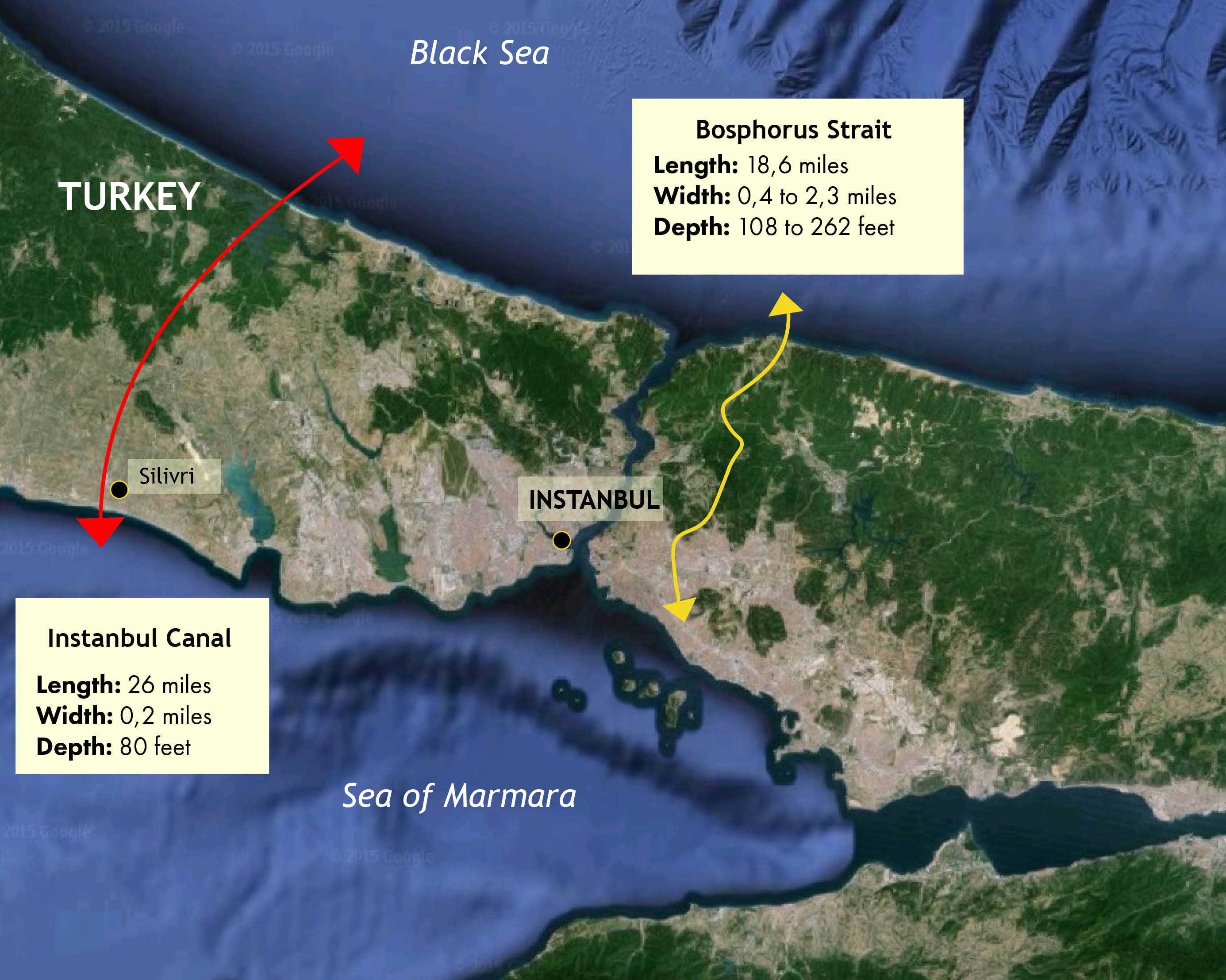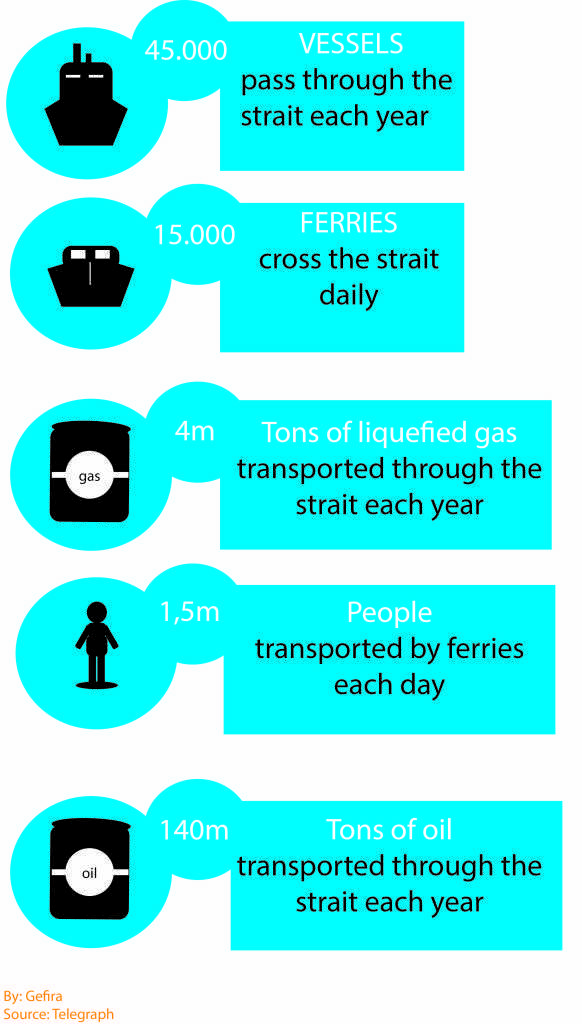The tension between the USA and Russia has grown enormously over the couple of months. The case of yet another Russian jet shot down by Turkey pushed Ankara into the American embrace. Iran and Syria has stood by Moscow, the guarantor of their independence of the Western powers. Turkey, faced with no real choice, decided to throw in her lot with the USA. Wasn’t it the Allies that won in World War One? Was Turkey not defeated then because she backed the wrong horse? So Erdogan, Turkey’s president for life, has taken his decision: let the Americans make use of Kanal İstanbul and move their fleet into the Black Sea. The Montreux Convention forbidding passage of navies through the Bosporus does not apply. It is not the Bosporus, it is Kanal İstanbul. The year is 2023, the canal has just been completed.
That might be a scenario playing out in the nearest future. If. If the idea for cutting a waterway through the mainland will have materialized within several years from now.
The idea for cutting through the mainland was brought up a few years ago; the legislation enabling the inception of the construction is slated for 2016; the gargantuan task for the nation has been set by its current leader Recep Tayyip Erdogan, and the time of its completion is to mark the centennial anniversary of the birth of the Turkish Republic. Such might be a concise and succinct description of the great effort: Kanal İstanbul.
The Canal
It was on 27th April 2011 that Recep Tayyip Erdogan, the then prime minister of Turkey (the one-time mayor of Istanbul) announced the biggest project of the century1: the construction of the canal that would be cut through the European part of Turkey, west of Istanbul, connecting the Black and the Marmara Seas. When completed, it will be 47 km long (the length of the Suez Canal is 193 km, and that of Panama Canal 77 km), 150 m wide and 25 m deep. The project also includes the construction of as many as six bridges and two towns with housing for half a million people. The cost of the whole enterprise is estimated at 20 billion and its completion is slated by 20232.

Mega Projects
Canal Istanbul, though the most impressive, is by no means the only challenge facing the nation. Turkey’s authorities have come up with an ambitious series of grand projects to commemorate the centennial anniversary of the birth of Turkey as a modern state. These huge projects include a railway tunnel under the Marmara Sea (already under construction), a third bridge over the Bosporus, an Istanbul airport (which will be the 3rd largest in the world), the Marmara highway, two pipelines (Transanatolian and Turkish Stream), the Istanbul Finance Centre and three nuclear power plants (the construction of the one in Akkuyu is in its initial phase)3.
Official Objective
The Turkish authorities claim the traffic in the passage through the Bosporus Strait becomes more and more congested with every year, which is a cause of accidents, including oil spills, and which damages the environment. The new canal will relieve the traffic in the natural strait allowing vessels to by-pass it. The strain on the environment will be significantly decreased; the safety of the traffic, increased. Unlike other man-made canals this one will not let shipowners economize on distance and time but on time only. Since the traffic through the Bosporus is very busy, vessels are sometimes forced to wait for several days.
True, within the meaning of the provisions of the Montreux Convention Turkey must not levy passage fees; still, ship owners, having taken into account the benefit and loss calculation, may prefer to circumvent the natural waterway, using Kanal İstanbul. This will provide an additional income for the region and contribute to its development4. After all, the Istanbul area is the most important for the whole country: as many as 20 million people live here. So far, so good, but the question arises whether the expectations of a profit and the resultant development will materialize.
In the run-up to the Montreux Convention
During the time of the Ottoman Empire the Straits remained under the rule of the sultans. As Turkey grew weaker and weaker, and the nations in the Balkans rebelled against the Ottoman rule, European powers sought to establish their dominance over the region. The greatest attempt at imposing its control over the Balkans and the Straits was made by the Russian Empire. The Russo-Turkish war that lasted from 1877 to 1878, though won by the Russian emperor, and changed the balance of powers in the Balkans, did not result in the significant weakening of Turkey. European powers intervened and the resultant Congress of Berlin prevented Turkey from greater territorial losses.
Then came World War One. At first Turkey tried to remain neutral, up to a time. Then Istanbul allowed two German vessels of war to seek safety in the Black Sea, passing through the Straits. The act was in breech of Turkey’s alleged neutrality and so slowly but surely Turkey let herself be drawn into the war on the side of Germany and Austria-Hungary. The Allies made an attempt at gaining control over the Dardanelles and the Bosporus. The Battle of Gallipoli (1915-16), the attack on the Dardanelles, claimed a large number of casualties but eventually the allied armies bogged down and they had to retreat; the Russian naval fleet remained locked in the Black Sea. Eventually the Central Powers lost the war, and so Turkey was regarded as a conquered nation.
By the Treaty of Sevres (1920) the territory adjoining the Straits was demilitarized and subjected to international control. The Ottoman Empire was partitioned, parts of its Anatolian territory occupied by Greeks and Italians. This caused a national uprising led by Kemal Pasha (the general who had the command of the Turkish forces at the Battle of Gallipoli), later to be granted the name of Atatürk, and the expulsion of the occupying forces. A new Treaty of Lausanne (1923) granted Turkey sovereignty over the Straits. This was soon followed by the Montreux Convention.
Montreux Convention
The provisions of the Montreux Convention guarantee the free passage of civilian vessels in peacetime and only allow Turkey to close the Straits in wartime or when threatened by aggression. Irrespective of whether there are hostilities, no aircraft carriers are allowed through; vessels of non-Black Sea states may only stay in the Black Sea for three weeks; as for submarines, they may only sail either to their base after construction or for repairs5.
Though no payment is allowed to be demanded for the passage of vessels, the Turkish government may, and does, collect money for (i) health inspection, (ii) maintenance of the lighthouse, and (iii) rescue services. In 2013 this amounted to almost five thousand USD for a commercial vessel with 10.000 tonnes6. The corollary to the convention lays down the exact number of ships and their size that can each time pass through the Straits; the provisions of the Convention are subject to reviews every twenty years. Another such review will take place in 2016.
Economic aspects
The Straits are a waterway for oil exports from the Black and Caspian Sea countries like Russia, Azerbaijan, and Turkmenistan. Turkey has two major international pipelines: Kirkuk-Ceyhan and Baku-Tblisi Ceyhan. Their joint capacity of transporting oil is almost twice as small as that of the tankers going through the Straits (1,7 mb/d as compared to 2,7 mb/d)7. Kanal İstanbul may double the amount transported through the Bosporus, so much so that its projected parameters in terms of width (150 m) and depth (25 m) will make it possible for very large crude carriers (VLCC) to pass through. Currently, it is Suezmax carriers that can make use of the waterway8. Thus Turkey might strengthen her economic position as one of the more important world energy hubs.
The proposed construction of the canal rivals that of the projected, though temporarily abandoned, Burgas–Alexandroupoli oil pipeline, a joint Russian, Bulgarian and Greek enterprise, which, if completed, would run close to the Turkish-Bulgarian and Turkish-Greek border, thus also bypassing the Straits. It might be, the Turkish government wanted to trump up the Russian project. Unlike Moscow, Sofia and Athens, Ankara is not, as yet, giving up on the ambitious plan. The legislation paving the way for the inception of the construction will be passed in June 20169. At present, since the construction of the Burgas–Alexandroupoli pipeline and the South Stream pipeline have been abandoned, Russia has shifted much of its oil tanker exports to the Baltic and through the Danish Straits. That move might pose an economic danger for the Istanbul Canal.
Political Aspects
What is the true purpose behind the proposed Kanal İstanbul? The Montreux Convention does not cover artificial canals. Never mind the doubtful profits to be gained from the waterway in the future: the geopolitical and strategic benefits appear to be of a far greater importance. Turkey or her allies will be able, without the slightest violation of the Montreux Convention, to move her or her ally’s vessels of war, aircraft or submarines, from the Mediterranean to the Black Sea and the other way round. Having such a passage between the two bodies of water will strengthen Turkey’s political and military leverage not only in the region but also globally10.
That is the reason why Russia has already expressed her fear about the project11. Turkey’s allies, which means the USA and other NATO member states, may gain the upper hand in the region in case of conflict. It should be borne in mind that the Straits are the only maritime exit for the Russian navy with its base in Sevastopol that can be used all year long. The war vessels on the Baltic may be blocked in their ports for as long as six to nine months yearly when the sea is frozen over12. These geopolitical prospects might cause some governments to boost up investment in the canal.
1 Outdoing Panama: Turkey’s ‘Crazy’ Plan to Build an Istanbul Canal Origins Current Events in Historical Perspective Origins Source: Origins 11-08-2011
2 Turkey’s “new Bosporus”: risks and benefits Source: Sputnik 26-08-2013
3 Invest in Turkey 18-08-2015 Source: 18-08-2015
4 Erdoğan’s giant Istanbul canal back on agenda with a new look Source: Hürriyet Daily News 24-02-2015
5 Russia urges Turkey to preserve Montreux Treaty Source: Hürriyet Daily News 29-04-2011
7 Kanal İstanbul: Pipedream or Politics? Source: Baker Institute
8 Kanal İstanbul: Pipedream or Politics? Baker Institute
9 Government prioritizes Istanbul Canal as tension rises with Russia Source: Daily Sabah 12-12-2015
10 Why Turkey is key to the Russia-Ukraine-EU crisis Source: Source: Al Arabiya News 19-04-2014
11 Turkey’s “new Bosporus”: risks and benefits Source: Sputnik 26-08-2013
12 What’s the deal with straits? Source: Daily Sabah 12-12-2015





One comment on “Kanal Istanbul: Within 7 Years US Aircraft Carriers Will Enter the Black Sea”
The Montreux Convention places limits on the presence of warships in the Black Sea independently of the regime in the Straits : see G. Plant ‘Dardanelles and Bosporus’ in Max Planck Encyclopedia of Public International Law and the books cited therein.